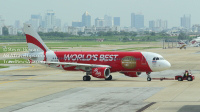|
In Q3 2013 AirAsia Group recorded a load factor
of 76%.
The total number of passengers carried for the
whole group grew by 27% year-on-year to approximately 10.61
million continuing its� double digit passenger growth, in line
with the increase in capacity which stood at 29%.
AirAsia Group took in 32 additional aircraft
y-o-y, which brings its total fleet at the end of September 2013
to 137 (142 including aircraft that were still located in Japan).
This is the first time Zest Air figures are consolidated
under Philippines� AirAsia and the group. In addition, following
the dissolution of AirAsia Japan, AAJ�s numbers are excluded from the
group�s figures.
Malaysia
AirAsia maintained a load factor of 77% in Q3 2013 despite
being a non-peak quarter due to the fasting month for the Muslims.
Compared to last period last year, MAA added additional 7 aircraft
part of its capacity management. With its continuous load active
and yield passive strategy, MAA reported a passenger increase of
11% y-o-y at 5.3 million matching with the 11% capacity increase.
MAA added frequencies on Kuala Lumpur � Kunming, Banda Acheh, Tiruchirappalli, and
Pekan Baru and introduced a new unique route this quarter � daily
flights from Kota Kinabalu to Hangzhou.
 |
|
Thai AirAsia reports load factor of 83% in Q3 2013. Click to Enlarge.
|
Thai
AirAsia continues to record an impressive load factor of
83% in Q3 2013 - 1 ppt increase y-o-y. The number of passengers
carried increased by 30% to 2.6 million, ahead of its increase in
capacity of 27%, suggesting a huge growth opportunity in the
market. During the quarter, TAA increased its frequencies in three
routes which were from Bangkok to Chong Qing, Kuala Lumpur and
Singapore. Y-o-y, TAA took in an additional of 6 aircraft (2
aircraft this quarter), bringing its total number of fleet to 31
at the end of September 2013.
Indonesia AirAsia
posted a load factor of 75% in Q3 2013 - down 3 ppt y-o-y
contributed from a record capacity of 41% y-o-y. The increase of
capacity was part of its capacity management targeting the
introduction of more international routes and increasing
frequencies on key domestic routes. Despite the slight decline in
load factor, passenger growth y-o-y was up 36% highlighting IAA�s
success in expanding its offline distribution channel and gaining
more market domestic share. Five new routes that was introduced
are: Bali � Darwin, Bali � Kota Kinabalu, Medan � Singapore,
Surabaya �Singapore, Makassar � Singapore. In addition to that,
IAA increased its frequencies in two routes: Medan � Jakarta,
Jakarta � Jogyakarta. At the end of the quarter, IAA has a total
of 26 aircraft, an additional of 7 aircraft y-o-y (2 were added
this quarter).
The operating statistics for
Philippines� AirAsia for this quarter moving forward is a
consolidation of PAA�s and Zest Air�s statistics and also the
launch of a unified brand of AirAsia Zest which will bring
stronger brand awareness. In Q3 2013, PAA reported a 4 ppts y-o-y
increase in its load factor to 59%. Total number of passenger
carried was 0.73 million � up 525% y-o-y, with a capacity increase
of 483% y-o-y. The increase in PAA�s operating numbers was due to
the focus on Manila slots. PAA has increased its frequencies in
five of its Manila routes and one in its Clark route: Manila �
Shanghai, Cebu, Kalibo, Bacolod, Tacloban and Clark � Hong Kong.
At the end of the period, PAA has a total of 14 aircraft which is
an increase of 12 aircraft y-o-y. Moving forward, the hub in Clark
will cease operations and will be moved to Manila.
Tune Hotel,
AirAsia,
AirAsia X
|
